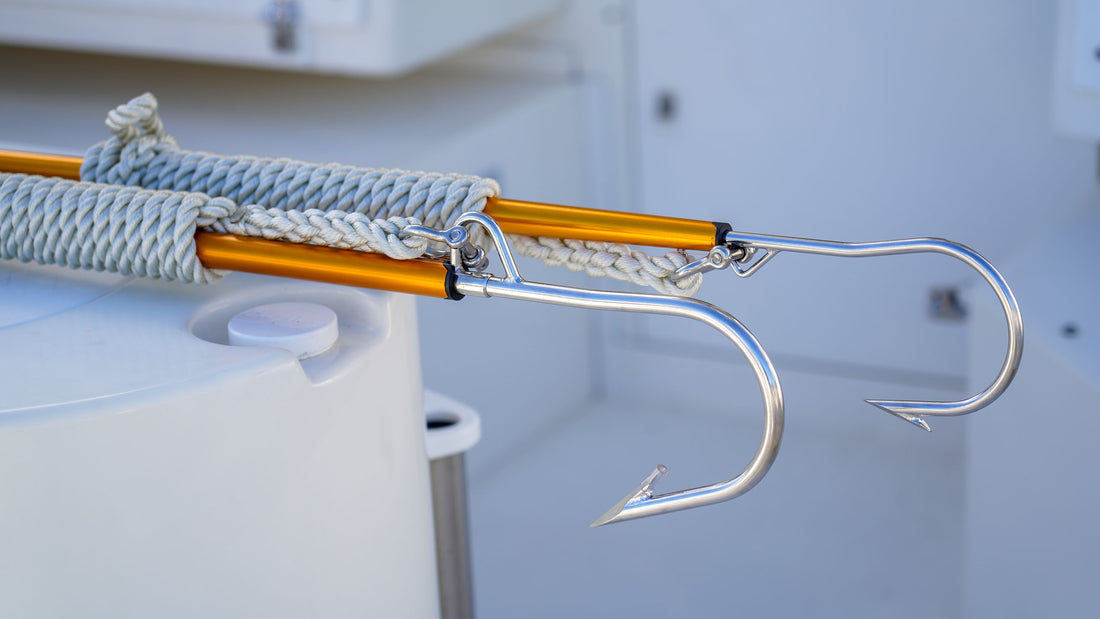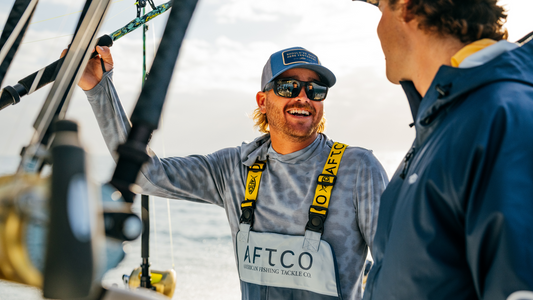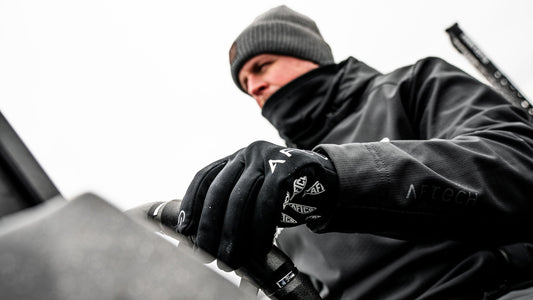
How to Use a Flying Gaff
A flying gaff is a specialized tool among serious big-game offshore enthusiasts. To better understand best practices for using a flying gaff properly, I turned to a leading expert in big-game tournament fishing, Capt. Karl Anderson. Anderson's home base is New Jersey, but he spends much of the year in the Bahamas and waters off Florida. When not up on the bridge of a sportfishing yacht, Anderson is a consultant, writer, and speaker.
What Is a Flying Gaff?
This specialized gaff uses a long rope secured to the base of the gaff hook. When a fish is struck and the hook is embedded, the gaff man firmly jerks the gaff handle so the hook detaches and is free, leaving the fish connected by a length of rope. Although flying gaffs are relied on less these days than in past years, there are times when it is an invaluable tool for very large fish.
When to Use a Flying Gaff
"When dealing with larger pelagic species, the flying gaff is an essential tool for crews to subdue and harvest a fish," Anderson says. He explains that having the ability to strike large fish without the gaff handle helps crews gain control and keep the fish close to the boat with much less risk.
When Not to Use a Flying Gaff
"Flying gaffs are not ideal for many situations," Anderson advises, "including gaffing sharks." He explains that they tend to roll once gaffed, "and they'll roll up the gaff line, creating quite a problem to subdue and control. So in this case a straight gaff is the preferred tool."
Similarly, when gaffing large tuna such as bigeye, yellowfin and giant bluefin, a straight gaff is preferred. "Gaffing a tuna in the head and then controlling his head is the end game. But a flying gaff gives a big tuna his head and ultimately risks pulling out, since the fish still has the ability to swim."
Know the Rules
If you're considering using a flying gaff, you should know the rules, Anderson says. That means International Game Fish Association rules, which are specific:
- Gaffs (including flying gaffs) and nets used to boat or land a fish must not exceed 2.44 meters (8 feet) in overall length. In using a flying or detachable gaff, the rope may not exceed 9.14 meters (30 feet). The gaff rope must be measured from the point where it is secured to the detachable head to the other end. Only the effective length will be considered. If a fixed head gaff is used, the same limitations shall apply and the gaff rope shall be measured from the same location on the gaff hook. Only a single hook is permitted on any gaff. Harpoons or lances are prohibited.
Anderson also points out that the IGFA forbids any use of a flying gaff for flyfishing records.
Choose the Optimal Size
Anderson explains that flying gaffs are sized by the bite of the hook, also known as the head of the gaff, measured from the tip across to the shank. AFTCO offers single-bar flying gaff heads in five sizes from a five-inch to a 13-inch hook. The size hook of course depends upon the size of fish you're targeting. "When targeting large marlin over 400 pounds, the larger-bite, back-banded gaffs are best." Back-banding involves a stiffening support brace welded around the outside of the hook bend to keep it from straightening, which Anderson points out, large fish have been known to do. For such big billfish, Anderson says, "AFTCO's 10-inch and 13-inch gaff heads are perfect solution for this task."
Most crews carry two sizes of flying-gaff heads, Anderson says, adding: "We carry four as we prefer to put two gaffs in the really large fish to fully secure them and keep the crew as safe as possible. Too big a gap on a smaller fish is not practical, and too small a gaff on a large fish puts you at a distinct disadvantage when subduing the fish." Anderson says where you're fishing also plays a part in what size gaff you should be using. "Being prepared for anything is always the best practice. You never know when that fish of a lifetime is going swim into your life!"
What Should the Gaff Shaft or Handle Look Like?
Anderson cites the AFTCO gaff handle as a prime example of effective design for its intended use: "It's a strong aluminum shaft with a twist-lock mount to hold the head, two foam hand grips, and a grooved end for securing the gaff rope."
Rigging a Flying Gaff: Best Practices
"Properly rigging any flying gaff is crucial for its successful use," Anderson explains. "We utilize gaffer's tape, a fabric tape, to secure the top of the gaff to the handle. It tears easily when applied in small strips, a common choice among lighting and sound crews in the film industry."
"The goal is to secure the gaff rope to the handle, hold the head in place, and prevent tangling in the cockpit while allowing easy detachment once the head is inserted into the fish."
"We use a rope ring with attached carabiners to hook the gaff rope. Some boats have chair base eyebolts for effortless clipping," Anderson continues.

Additional Tips for Rigging AFTCO Flying Gaffs
AFTCO Flying Gaffs are best rigged with soft 5/8-inch diameter three-strand nylon rope directly spliced to the hook eye. While IGFA permits a maximum combined length of 25 feet for the total rope and hook, it's advisable for the rope length to match the farthest reach of a crew member wielding the gaff from its attachment point on the boat. Flying gaff hooks should be fastened to the stainless attaching post on the aluminum handle using a single turn of 20- or 30-pound line. Ensure the nylon rope is taut, passing it around the end of the handle, through the gimbal, and back up past the second handle grip. Secure it with a couple of wraps of 1-inch masking tape. The rope should be gripped to the handles by the gaffer, and released as soon as the gaff hook is planted into the fish and breaks loose from the handle.
Deploying the Flying Gaff
Attaching the flying-gaff rope to the fighting chair offers a central point of connection that gives crews flexibility to gaff the fish on whichever side of the boat it's coming into. "We prefer not to gaff a fish at the transom," Anderson says. "It's always best to take fish on the side the boat, so the boat can continue to move forward slowly. Once the boat stops the fish can get underneath the boat too easily where it risks mutilation," disqualifying it per IGFA and tournament rules.
Anderson considers it imperative to be sure the crewman using the gaff knows how and where to best strike the fish, as well as how to release the gaff head to get the handle out of the way, then secure the gaff rope to keep the fish close to the boat.
"During the endgame, things can get heated, and having a good gaff man who is prepared and can multitask is a huge help," Anderson says. "It's not enough to strike the fish and let things happen."
Crew handling the flying gaff should never be in front of the wireman, says Anderson. "The wireman needs the ability to control the fish if surges forward," Anderson says. "If the gaff man is standing in his way with a gaff, the risk of losing the fish is greatly increased." Only when the fish is within striking distance, should the gaff man come in behind the wireman.
Anderson advises to "aim for the fish's eye if possible." The reason, he goes on, is "because with the boat moving forward, once the gaff hits the water, it's pulled back by the water pressure. The gaff man must be prepared for this water drag, hopefully making his shot strike in the head or shoulder. With a very big fish," Anderson says, "a second gaff should be deployed immediately to keep the fish from turning its head and getting away."
Once the fish is struck, the gaff man must immediately begin the process of cleating off the rope as closely as possible. "With [the legal maximum of] 30 feet overall of gaff head and rope, from the chair to the cover board we lose 10 feet on most inboard boats, giving us 20 feet of rope that needs to be taken up and cleated off to keep the fish pinned to the side of the boat so it doesn't get under the boat or have the ability to swim down and gain enough momentum to pull gaffs out and swim away."







